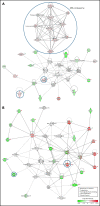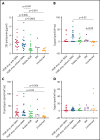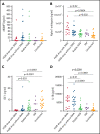Plasma biomarkers of hemoglobin loss in Plasmodium falciparum-infected children identified by quantitative proteomics
- PMID: 34871370
- PMCID: PMC9012130
- DOI: 10.1182/blood.2021014045
Plasma biomarkers of hemoglobin loss in Plasmodium falciparum-infected children identified by quantitative proteomics
Abstract
Anemia is common among young children infected with Plasmodium falciparum and severe malarial anemia (SMA) is a major cause of their mortality. Two major mechanisms cause malarial anemia: hemolysis of uninfected as well as infected erythrocytes and insufficient erythropoiesis. In a longitudinal birth cohort in Mali, we commonly observed marked hemoglobin reductions during P falciparum infections with a small proportion that progressed to SMA. We sought biomarkers of these processes using quantitative proteomic analysis on plasma samples from 9 P falciparum-infected children, comparing those with reduced hemoglobin (with or without SMA) vs those with stable hemoglobin. We identified higher plasma levels of circulating 20S proteasome and lower insulin-like growth factor-1 (IGF-1) levels in children with reduced hemoglobin. We confirmed these findings in independent enzyme-linked immunosorbent assay-based validation studies of subsets of children from the same cohort (20S proteasome, N = 71; IGF-1, N = 78). We speculate that circulating 20S proteasome plays a role in digesting erythrocyte membrane proteins modified by oxidative stress, resulting in hemolysis, whereas decreased IGF-1, a critical factor for erythroid maturation, might contribute to insufficient erythropoiesis. Quantitative plasma proteomics identified soluble mediators that may contribute to the major mechanisms underlying malarial anemia. This study was registered at www.clinicaltrials.gov as #NCT01168271.
© 2022 by The American Society of Hematology.
Figures







Comment in
-
What causes malaria anemia?Blood. 2022 Apr 14;139(15):2268-2269. doi: 10.1182/blood.2021015055. Blood. 2022. PMID: 35420692 No abstract available.
Similar articles
-
Primaquine or other 8-aminoquinoline for reducing P. falciparum transmission.Cochrane Database Syst Rev. 2014 Jun 30;(6):CD008152. doi: 10.1002/14651858.CD008152.pub3. Cochrane Database Syst Rev. 2014. Update in: Cochrane Database Syst Rev. 2015 Feb 19;(2):CD008152. doi: 10.1002/14651858.CD008152.pub4. PMID: 24979199 Free PMC article. Updated.
-
Primaquine or other 8-aminoquinoline for reducing Plasmodium falciparum transmission.Cochrane Database Syst Rev. 2015 Feb 19;(2):CD008152. doi: 10.1002/14651858.CD008152.pub4. Cochrane Database Syst Rev. 2015. Update in: Cochrane Database Syst Rev. 2018 Feb 02;2:CD008152. doi: 10.1002/14651858.CD008152.pub5. PMID: 25693791 Free PMC article. Updated.
-
Primaquine or other 8-aminoquinolines for reducing Plasmodium falciparum transmission.Cochrane Database Syst Rev. 2018 Feb 2;2(2):CD008152. doi: 10.1002/14651858.CD008152.pub5. Cochrane Database Syst Rev. 2018. PMID: 29393511 Free PMC article.
-
Primaquine for reducing Plasmodium falciparum transmission.Cochrane Database Syst Rev. 2012 Sep 12;(9):CD008152. doi: 10.1002/14651858.CD008152.pub2. Cochrane Database Syst Rev. 2012. Update in: Cochrane Database Syst Rev. 2014 Jun 30;(6):CD008152. doi: 10.1002/14651858.CD008152.pub3. PMID: 22972117 Updated.
-
Ficolin-1 in pediatric Plasmodium falciparum malaria and its possible role in parasite clearance and anemia.Infect Immun. 2025 Jul 8;93(7):e0019425. doi: 10.1128/iai.00194-25. Epub 2025 May 27. Infect Immun. 2025. PMID: 40422078 Free PMC article.
Cited by
-
Plasmodium knowlesi Infection Is Associated With Elevated Circulating Biomarkers of Brain Injury and Endothelial Activation.J Infect Dis. 2025 Jun 2;231(5):e966-e975. doi: 10.1093/infdis/jiae553. J Infect Dis. 2025. PMID: 39658124 Free PMC article.
-
Hormones in malaria infection: influence on disease severity, host physiology, and therapeutic opportunities.Biosci Rep. 2024 Nov 27;44(11):BSR20240482. doi: 10.1042/BSR20240482. Biosci Rep. 2024. PMID: 39492784 Free PMC article. Review.
References
-
- Stevens GA, Finucane MM, De-Regil LM, et al. ; Nutrition Impact Model Study Group (Anaemia) . Global, regional, and national trends in haemoglobin concentration and prevalence of total and severe anaemia in children and pregnant and non-pregnant women for 1995-2011: a systematic analysis of population-representative data. Lancet Glob Health. 2013;1(1):e16-e25. - PMC - PubMed
-
- Yang W, Liu B, Gao R, Snetselaar LG, Strathearn L, Bao W. Association of anemia with neurodevelopmental disorders in a nationally representative sample of US children. J Pediatr. 2021;228:183-189.e2. - PubMed
Publication types
MeSH terms
Substances
Associated data
Grants and funding
LinkOut - more resources
Full Text Sources
Medical
Miscellaneous

